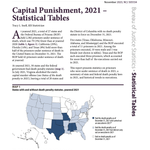
Introduction
There is no accurate measure of the length of time prisoners spend on death row. Some prisoners are on death row for only a short period of time before their convictions or death sentences are overturned in the courts. Other have spent more than four decades on death row before being exonerated or being non-capitally resentenced.
Half of all death-row exonerations have taken more than a decade, and the length of time between conviction and exoneration has continued to grow. More than half of the exonerations since 2013 have taken 25 years or more.
The length of time prisoners spend on death row in the United States before being executed began to emerge as a topic of interest in the debate about the death penalty in the early 2000s. The discussion increased around the 2005 execution of Michael Ross, a Connecticut inmate who had been on death row for 17 years, and has been spurred by the writings of several Supreme Court Justices — most recently Justice Stephen Breyer — who have unsuccessfully urged the Court to consider this issue.
Death-row prisoners in the U.S. typically spend more than a decade awaiting execution or court rulings overturning their death sentences. More than half of all prisoners currently sentenced to death in the U.S. have been on death row for more than 18 years.
While on death row, those serving capital sentences are generally isolated from other prisoners, excluded from prison educational and employment programs, and sharply restricted in terms of visitation and exercise, spending as many as 23 hours a day alone in their cells.
This raises the question of whether death-row prisoners are being subject to two distinct punishments: the death sentence itself and the years of living in conditions tantamount to solitary confinement — a severe form of punishment that may be used only for very limited periods for general-population prisoners.
Moreover, unlike general-population prisoners, even in solitary confinement, prisoners on death-row live in a state of constant uncertainty over when they will be executed. For some death-row prisoners, this isolation and anxiety results in a sharp deterioration in their health and mental status.
Background
When the constitution was written, the time between sentencing and execution could be measured in days or weeks. A century later, the Supreme Court noted that long delays between sentencing and execution, compounded by a prisoner’s uncertainty over time of execution, could be agonizing, resulting in “horrible feelings” and “immense mental anxiety amounting to a great increase in the offender’s punishment.” (In re Medley, 1890, as cited in Foster v. Florida, 2002). The time frame at issue in In re Medley: four weeks.
But in the wake of the Supreme Court-mandated suspension of the death penalty in 1972 and its declaration in 1976 that meaningful appellate review was a prerequisite to any constitutionally acceptable scheme of capital punishment, numerous reforms have been introduced in an attempt to create a less arbitrary system. This has resulted in lengthier appeals, as mandatory sentencing reviews have become the norm, and continual changes in laws and technology have necessitated reexamination of individual sentences.
Death penalty proponents and opponents alike say such careful review is imperative when the stakes are life and death. “People are adamant … that every avenue should be exhausted to make sure there is no chance (the condemned) are not guilty,” former Georgia Attorney General Mike Bowers said in 2001. “The surer you are, the slower you move.” (Atlanta Constitution, October 27, 2001).
The years it takes to carry out a death sentence exact a huge toll — on taxpayers, victims’ families, and the prisoners themselves. Yet without thorough appeals, mistakes or misconduct in death penalty cases would be missed or remain concealed. As of June 2021, 33 of the men and women wrongfully convicted and sentenced to death since states resumed capital punishment in the 1970s had waited 20 or more years to be exonerated. Seventeen who were exonerated between 2010 and June 2021 had waited 25 years or more for their exonerations and, for twelve, exoneration took 30 years or more.
Characteristics of Death-Row Prisoners
The following information is taken from the Bureau of Justice Statistics: Capital Punishment and is the statistical data of the death-row population for 12/31/2019.
- 56.1% of the death-row population is White, 41.4% is Black, 1.6% is Asian/Native Hawaiian/Other Pacific Islander, and .8% is American Indian/Alaska Native. BJS records Hispanic/Latino origin as ethnicity, not race, however, and many Latinx prisoners (who comprise 15.1% of death row) are listed by BJS as White.
- Men make up 98% of those on death row; women make up 2%
- The median education level of death-row prisoners is 12th grade.
- 55.5% of death-row prisoners have never married; 19.6% are divorced or separated; 21.3% are currently married; and 3.6% are widowed.
- 28.2% of death-row prisoners are age 25 to 44. and 54.8% are 50 or older.
- 9.5% of death-row prisoners had a prior homicide conviction.
- 67.8% had prior felony convictions.
The following information is taken from the Bureau of Justice Statistics: Capital Punishment and is the statistical data of the death-row population for 12/31/2008 (the last year that this data was publicly reported.)
- Among all prisoners under sentence of death, half were age 20 to 29 at the time of arrest; 10.5% were age 19 or younger; and 1% were age 55 or older.
- The average age at time of arrest was 29 years.
The Aging of the Death Row Population
America’s death row population is aging significantly: Five hundred and seventy-four prisoners were 60 years old or older as of 2019. That figure represents a growing senior death row population, which numbered just 39 in 1996. Some death row seniors committed crimes late in life, but many are there at such advanced age because of the inevitable slowness of the capital appeals process. Unlike elderly prisoners in the general population, death row seniors typically are not housed in prison geriatric facilities or placed in “end of life” programs, but rather are often segregated in individual cells within special facilities.
Legal scholars have argued that executing people who have become so old is inconsistent with humanitarian values. “Dead man walking is one thing,” said Jonathan Turley, a George Washington University law professor who has worked with older prisoners. “Dead man being pushed along to the execution chamber in a wheelchair is another thing.” (USA Today, February 10, 2005).
On December 9, 2021, Oklahoma executed 79-year-old Bigler Stouffer, its oldest death-row-prisoner and the oldest person to be executed in that state. James Frazier, Ohio’s oldest death-row prisoner, was scheduled to be executed October 20, 2021, before dying of COVID on November 19, 2020. He suffered from dementia following a series of strokes, could not walk, and required the assistance of aides to complete daily tasks. His lawyers had filed a petition to bar his execution on grounds of mental incompetency.
In 2018, one year after executing 75-year-old Thomas Arthur, Alabama executed 83-year-old Walter Moody, the oldest person and only octogenarian put to death in the United States since executions resumed in 1977. A DPIC analysis of U.S. execution data found that only three of the 944 prisoners executed in the United States between 1977 and 2004 had been aged 65 or older. That total was matched in the first six months of 2019, with the executions of Billie Coble (70), Donnie Johnson (68), and Robert Long (65). In 23 years of executions between 1977 and the close of the 20th century, only ten prisoners aged 60 or older were executed. Forty-five prisoners aged 60 or older were executed between January 2010 and June 2019, 23 since 2015 alone.
With the aging of death row, states and courts are grappling with how issues of age-related physical and mental decline affect executions. In 2004, a 74-year-old man was put to death in Alabama for a murder he committed in 1977. Before his execution, J.B. Hubbard forgot who he was at times because of dementia. He suffered from colon and prostate cancer, and he was so weak that other inmates sometimes walked him to the shower and combed his hair. (Washington Post, August 6, 2004).

Ohio tried and failed to execute terminally ill 69-year-old Alva Campbell (pictured) in November 2017. Campbell was afflicted with lung cancer, chronic obstructive pulmonary disease, respiratory failure, prostate cancer, and severe pneumonia; he relied on a colostomy bag, needed oxygen treatments four times a day, and required a walker for even limited mobility. After failing four times to find a suitable vein in which to set an intravenous execution line, Ohio called off the execution. Governor John Kasich granted Campbell a temporary reprieve and rescheduled his execution for June 2019. Campbell died of his terminal illness less than six months later.
The U.S. Supreme Court stayed the execution of 67-year old Alabama prisoner Vernon Madison in 2018 based on concerns that he was incompetent to be executed. Madison suffered multiple severe strokes that caused him brain damage, vascular dementia, and retrograde amnesia. The strokes also left him with slurred speech, legally blind, incontinent, and unable to walk independently. In addition to having no memory of the offense, he can no longer recite the alphabet past the letter G, soils himself because he does not know there is a toilet in his cell, asks that his mother — who is dead — be informed of his strokes, and plans to move to Florida when he is out of jail. The State of Alabama had argued that Madison’s dementia was not a bar to execution, but in a 2019 ruling, the U.S. Supreme Court ruled that cognitive issues associated with dementia could render a prisoner incompetent to be executed.
International Perspectives
Numerous international human rights treaties explicitly prohibit governments from subjecting individuals to “cruel, inhuman or degrading treatment or punishment.” The prohibition is among the core principles included in the Universal Declaration of Human Rights in 1948 shortly after the formation of the United Nations (Article 5), the International Covenant on Civil and Political Rights (Article 7), the Convention Against Torture and Other Cruel, Inhuman or Degrading Treatment or Punishment (Preamble and Article 16), and the Convention on the Rights of Persons with Disabilities (Article 17), among other human rights instruments. A growing body of international case law suggests that extended confinement on death row under threat of execution constitutes cruel, inhuman, or degrading punishment.
In his dissenting statement in Elledge v. Florida in 1998, Justice Stephen Breyer noted that British jurists have suggested that the Bill of Rights of 1689 – a key part of English common law that Breyer described as “relevant to the interpretation of our own Constitution” – may prohibit some delays as cruel and unusual. In a landmark 1993 ruling, the Judicial Committee of the Privy Council – the British court that serves as the highest appeals court for Caribbean Commonwealth countries – ruled that executing prisoners after they had already spent more than five years on death row was “inhumane and degrading,” amounting to unconstitutional double punishment. Such prisoners, the court held, must have their death sentences commuted to life in prison. (The Independent, Nov. 3, 1993).
The committee’s seven Law Lords did not rule that the death penalty itself was unconstitutional. But “there is an instinctive revulsion against the prospect of hanging a man after he has been held under sentence of death for many years,” they wrote. “What gives rise to this instinctive revulsion? The answer can only be our humanity. We regard it as an inhuman act to keep a man facing the agony of execution over a long extended period of time.” (Ibid). The decision, known as the Pratt and Morgan ruling, resulted in the commutation of scores of death sentences in Jamaica, Bermuda, Barbados, and Trinidad and Tobago, cutting the death row population of English-speaking Caribbean nations by more than half. (The Miami Herald, September 8, 1998).
The Supreme Court of Canada, which does not have the death penalty, ruled in 2001 that two Canadian citizens charged with murder in Washington state could be extradited to the United States only with the guarantee that they would not receive the death penalty. The Canadian court found that the potential for long incarcerations before execution was a “relevant consideration” in determining whether extradition violates principles of “fundamental justice.” (United States v. Burns, S.C.R. 283, 353, 123, cited in Foster v. Florida, 2002).
In 2009, the President of Kenya commuted the death sentences of all of the country’s more than 4,000 death row prisoners to life, citing the wait to face execution as “undue mental anguish and suffering.”
Death Row Syndrome/Death Row Phenomenon
Psychologists and lawyers in the United States and elsewhere have argued that protracted periods in the confines of death row can make prisoners suicidal, delusional and insane. Some have referred to the living conditions on death row – the bleak isolation and years of uncertainty as to time of execution – as the “death row phenomenon” and the psychological effects that can result as “death row syndrome.” The origins of these concepts are often traced to the 1989 extradition hearings of Jens Soering, a German citizen who was charged with murders in Virginia in 1985 and who fled to the United Kingdom.
Soering argued to the European Court of Human Rights that the conditions he would face during the lengthy period between sentencing and execution would be as psychologically damaging as torture.
The court agreed. In its ruling that he could not be sent to a place that would sentence him to death, the court cited not the death penalty itself, but rather the “Death Row phenomenon” in which prisoners spent years awaiting execution while their cases were appealed. (Associated Press, July 27, 1989). Soering was extradited in 1990, but only with the prosecutors’ promise not to seek the death penalty.
The Soering case has been cited as precedent in international extradition cases, though today courts in countries without the death penalty often will not extradite to the United States because of the possibility of execution itself, regardless of how long the wait on death row, since the death penalty itself is seen as a violation of human rights.
Conclusion
The time that U.S. prisoners spend on death row has gotten increasingly longer in recent years and raises questions about the constitutionality of this added punishment. Although the U.S. Supreme Court has not addressed this issue, it has been repeatedly cited as a serious concern by death penalty experts in the U.S. and by courts outside the U.S. Shortening the time on death row would be difficult without either a significant allocation of new resources or a risky curtailment of necessary reviews.
News & Developments
News
Jan 29, 2025
12:01: The Death Penalty in Context — The Death Penalty in 2024
In this month’s episode of 12:01: The Death Penalty in Context, Managing Director Anne Holsinger speaks with DPI Communications Associate Hayley Bedard, about The Death Penalty in 2024, which highlights trends and events related to the death penalty. 2024 marked the tenth consecutive year during which fewer than 30 people were executed (25) and fewer than 50 people were sentenced to death (26), while high profile cases of death-sentenced people attracted…
Read MoreNews
Apr 08, 2024
Ohio’s Attorney General’s Report Describes Death Penalty as “Enormously Expensive” and “Broken” in 2023 Capital Crimes Report
“At a time when faith in society’s institutions is at an all-time low, the failure of the capital-punishment system could be Exhibit A,” concludes the annual Capital Crimes Report issued by by Ohio Attorney General Dave Yost. The Report highlights numerous problems with its“broken” capital punishment system, including the“enormously…
Read MoreNews
Nov 22, 2023
NEW RESOURCE: Bureau of Justice Statistics Reports 2021 Showed 21st Consecutive Year of Death Row Population Decline
U.S. Department of Justice, Bureau of Justice Statistics (BJS) released its latest report for the year 2021, confirming a continued decrease in the number of people on death rows in the…
Read MoreNews
Apr 17, 2023
Ohio’s 2022 Capital Crimes Report Calls State Death Penalty a ‘Broken System’
On March 31, 2023, Ohio Attorney General Dave Yost released the state’s annual Capital Crimes report for 2022. According to the report, the average time prisoners spend on the state’s death row before an execution date is set is nearly 21 years – a number that has consistently increased with each annual report. Even when an execution date is set, a prisoner“is more likely to die of suicide or natural causes than as a result of execution,” due to the ongoing…
Read MoreNews
Mar 20, 2023
INTERNATIONAL: Longest Serving Death Row Prisoner in the World Has Case Reversed
On March 13, 2023 in Japan, Tokyo’s High Court granted a retrial for Iwao Hakamada, a former boxer known as the“longest serving death row” prisoner in the world. He was convicted of murder in 1968. Hideaki Nakagawa, Director of Amnesty International Japan, described the ruling as a“long-overdue chance to deliver some…
Read More


